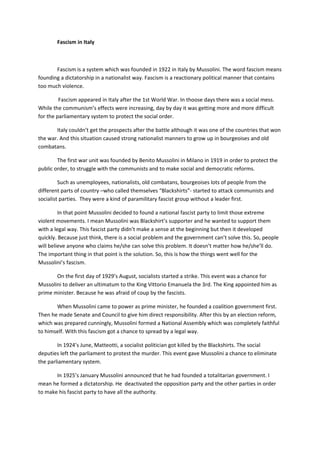
Fascism in italy
- 1. Fascism in Italy Fascism is a system which was founded in 1922 in Italy by Mussolini. The word fascism means founding a dictatorship in a nationalist way. Fascism is a reactionary political manner that contains too much violence. Fascism appeared in Italy after the 1st World War. In thoose days there was a social mess. While the communism’s effects were increasing, day by day it was getting more and more difficult for the parliamentary system to protect the social order. Italy couldn’t get the prospects after the battle although it was one of the countries that won the war. And this situation caused strong nationalist manners to grow up in bourgeoises and old combatans. The first war unit was founded by Benito Mussolini in Milano in 1919 in order to protect the public order, to struggle with the communists and to make social and democratic reforms. Such as unemployees, nationalists, old combatans, bourgeoises lots of people from the different parts of country –who called themselves “Blackshirts”- started to attack communists and socialist parties. They were a kind of paramilitary fascist group without a leader first. In that point Mussolini decided to found a national fascist party to limit those extreme violent movements. I mean Mussolini was Blackshirt’s supporter and he wanted to support them with a legal way. This fascist party didn’t make a sense at the beginning but then it developed quickly. Because just think, there is a social problem and the government can’t solve this. So, people will believe anyone who claims he/she can solve this problem. It doesn’t matter how he/she’ll do. The important thing in that point is the solution. So, this is how the things went well for the Mussolini’s fascism. On the first day of 1929’s August, socialists started a strike. This event was a chance for Mussolini to deliver an ultimatum to the King Vittorio Emanuela the 3rd. The King appointed him as prime minister. Because he was afraid of coup by the fascists. When Mussolini came to power as prime minister, he founded a coalition government first. Then he made Senate and Council to give him direct responsibility. After this by an election reform, which was prepared cunningly, Mussolini formed a National Assembly which was completely faithful to himself. With this fascism got a chance to spread by a legal way. In 1924’s June, Matteotti, a socialist politician got killed by the Blackshirts. The social deputies left the parliament to protest the murder. This event gave Mussolini a chance to eliminate the parliamentary system. In 1925’s January Mussolini announced that he had founded a totalitarian government. I mean he formed a dictatorship. He deactivated the opposition party and the other parties in order to make his fascist party to have all the authority.
- 2. FASCISM’S END IN ITALY In the 2nd World War Italy was Germany’s aly. This caused fascism to lose its importance in Italy . Because things started to change. The negative that came with the 1st World War was leaving. So, people started to believe that they don’t need fascism anymore. Parties that against to fascism became stronger. As a result Mussolini fell from power. He got arrested by the King’s command. But then he rescued by Germans and he founded a republician and a fascist government in the North Italy. This government came to end when the people who are against to the fascism fusilladed Mussolini. FASCISM HAS 4 PRINCIPLES • Superiority of the President : President who has all the delegated power is the first step of dictatorship. There is a motto “Duce is always right.” • Superiority of the Fascist Party : Fascist party has the same meaning with the government. This party shows its existence in everywhere. It steers the adolescents towards fascism to keep it alive. • Making the whole nation “Political” : Fascism wants the whole country to be in politics whereas so many dictatorship refuses this. For this Mussolini contidioned the nation with an effective propoganda which was supported by pres, radio and cinema. • Superiority of the Italian Nation : Mussolini’s aim with fascism was to make Italy one of the biggest and the most powerful countries. So, he wanted to increase the population. He forbidded the migration as a precaution.